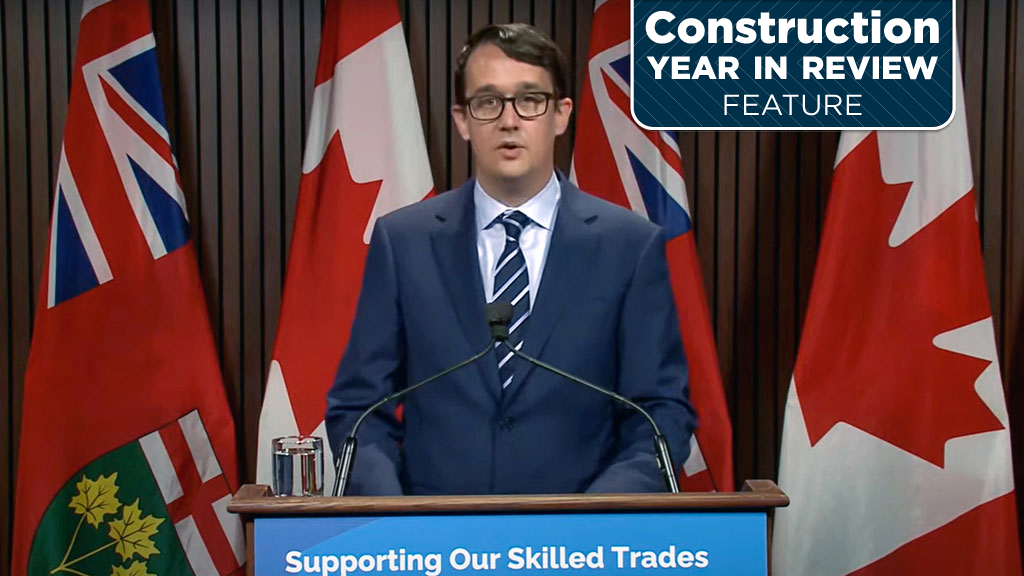For Ontario’s construction stakeholders, the top newsmakers of the year for 2021 weren’t just issues such as supply chain disruptions, the housing crisis and the skilled labour shortage, they were also people, specifically members of the provincial government.
While the COVID-19 pandemic has created a number of challenges across the industry, Richard Lyall, president of the Residential Construction Council of Ontario (RESCON) said it has also highlighted pre-existing problems and prompted action.
“Pre-pandemic the industry was facing considerable challenges and what the pandemic has done has introduced additional challenges,” said Lyall. “The pandemic has forced many to recognize, address in a meaningful way and actually do something about some of these problems that we are dealing with.”
He pointed out things like apprenticeship reform, the skilled labour shortage, immigration, the housing crisis and streamlining the development approvals process have all received a lot of attention over the past few years.
“I think 2021 was an awakening year where we’re starting to connect the dots on these things,” said Lyall, using housing as an example. “This year everyone gets we’ve got a supply problem and we’re doing something about it.”
Stephen Hamilton, director of public affairs, Ontario, for the Progressive Contractors Association of Canada, said the biggest issue in 2021 is the skilled labour shortage which has historically been a problem in the industry but has become worse with the pandemic.
“In the past these were regional concerns but it seems across Ontario and across Canada every sector in construction is dealing with issues in terms of labour supply,” said Hamilton.
From a legislative and regulatory standpoint, the biggest change for 2021 would be the official winding down of the Ontario College of Trades and the move to Skilled Trades Ontario. Hamilton said stakeholders will be paying attention to what “Skilled Trades Ontario looks like, what the board looks like and some of the early decisions in 2022. I think that is going to set a framework for how it operates going forward.”
Giovanni Cautillo, president of the Ontario General Contractors Association, said the result and effects of the COVID-19 pandemic took the top spot for the association, specifically supply chain disruptions.
“It sent our entire industry into a bit of a tailspin simply because all the tried-and-true methodologies of just in time couldn’t apply based on the fact that we couldn’t get product in,” Cautillo explained. “It caused serious delays.”
In terms of people, Cautillo applauded the work of Minister of Labour, Training and Skills Development Monte McNaughton.
“He was constantly making announcements on the skilled trades and attempting to attract people to construction,” Cautillo said. “That in our eyes assists construction by leaps and bounds bringing in more people, attracting more people and adding more people to the labour shortage that we are currently facing.”
He also said Ontario’s Chief Prevention Officer Ron Kelusky, who retired in September, should be commended for the way he stepped up and helped the industry during COVID-19.
“He was constantly engaged with the stakeholders in the industry, he was constantly on calls with us, he was constantly reaching out and touching base about every little nuance,” he said.
Retirements were also a top issue for the Council of Ontario Construction Associations (COCA).
“Ron (Kelusky) was so invested in his work and engaged,” said COCA president Ian Cunningham in an email to the Daily Commercial News. “He took over where is predecessors…left off and finally landed accreditation, whose name was changed to Supporting Ontario’s Safe Employers. He also led the development of and finalized the second provincial health and safety strategy that aligns all the prevention work of the provincial health and safety system partners.”
The second retirement was that of Patrick Dillon, head of the Provincial Building Trades, who he said is “perhaps the most consequential figure in the construction industry in Ontario in the last quarter century.”
“He served on virtually every public board that has any relevance to construction,” Cunningham said. “He worked across the management–union divide and with political parties of all stripes to get things done…He shared his wisdom freely and mentored others both in management and his brothers in the Building Trades. Above all, he was a health and safety champion.”
For Nadia Todorova, executive director of the Residential and Civil Construction Alliance of Ontario, a highlight this year was the Financial Accountability Office report, released in August, which reviewed Ontario’s municipal infrastructure and provided an assessment of the state of infrastructure repair.
“Anytime you have quantitative detailed data like that is very helpful because it provides scope scale on the conditions on the ground and allows for proper financial planning by decision makers on necessary investments that must take place,” said Todorova.
She added the provincial government is a construction newsmaker because of the various investments made in infrastructure across Ontario.
“From our perspective transportation projects such as the Bradford bypass and Highway 413 are going to be providing that necessary infrastructure to meet the growth in population and employment that Ontario is expecting,” she said.
Patrick McManus, executive director of the Ontario Sewer and Watermain Construction Association (OSWCA), said the biggest issue of 2021 for OSWCA was the Safe Restart 2.0 funding for municipalities from the provincial and federal governments in the spring.
“There was a lot of anxiety coming into 2021 about whether municipalities would have money to spend on capital works,” McManus explained. “Many of the big urban centres had big holes in their budgets due to COVID-related expenses and they were robbing their capital program budgets to plug this financial gap…This investment kept projects flowing and the industry working, which was imperative to keeping our economy stable.”








Recent Comments
comments for this post are closed